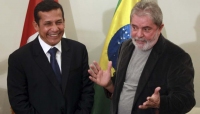 Ollanta Humala and Lula da SilvaPresident Ollanta Humala has made no secret of his admiration for the model employed by former President Luiz Inacio Lula da Silva in Brazil: a combination of free market orthodoxy in economic policy with some bold initiatives in the area of social policy.
Ollanta Humala and Lula da SilvaPresident Ollanta Humala has made no secret of his admiration for the model employed by former President Luiz Inacio Lula da Silva in Brazil: a combination of free market orthodoxy in economic policy with some bold initiatives in the area of social policy.
In Brazil it appears to have largely worked well. Poverty rates and indices of social inequality both fell, as did regional inequality between the poverty-stricken north-east and the more prosperous south. It also worked well for Lula himself, who finished his eight years in office with a popularity rating of over 80%.
In choosing his cabinet, Humala seems to have been influenced by his new mentor.
The key economic posts have all gone to people whose appointment is designed to placate the voracious markets. The message is one of ‘business as usual’. The re-appointment of Julio Velarde as president of the central bank (BCRP) was designed to placate the investor community, as was the last-minute choice of Luis Miguel Castilla to fill the all-important post of minister of economy and finance. Castilla was previously former President Alan García’s treasury minister, and before that had a history of working in international financial institutions like the World Bank, the IDB and the Andean Development Corporation (CAF). Even the choice of Salomón Lerner Ghitis as prime minister (president of the council of ministers) appears designed to have a key interlocutor between the world of Humala’s political alliance Gana Perú and that of business.
At the same time, Humala has put left-of-centre people in charge of social policy. Key here is the choice of Aida García Naranjo as the next women’s minister. García Naranjo is a close associate of Javier Diez Canseco, the tireless human rights crusader who returns to a seat in Congress (he was keynote speaker at last year’s PSG conference). In fact, the name of her department will change from here on to that of ministry of social inclusion. This is likely to become the power-house of the Humala administration’s revamped social policy, far more important than other ‘social’ ministries such as education and health.
But will this mix of economic orthodoxy and economic activism work in the Peruvian context? Clearly, Peru is not Brazil and Humala’s inheritance is different to that of Lula’s in 2003. In attempting to replicate the Brazilian experience in Peru, the new president is likely to face the following challenges:
Firstly, much will depend on whether the Peruvian business elite will show itself sufficiently enlightened to realise that improved social conditions are in its own long-term interest, even though it might have to make some sacrifices to get there. The reaction in business circles to the election of Humala, throughout the election period, gives pause for thought. Attitudes to Humala and what he represents are more than a little tinged by prejudice and even racism towards someone who is not from the traditional political stable. To pay for social reform will mean raising taxes and wages, things which business groups are likely to resist by every means at their disposal.
Secondly, the election of Humala is unlikely to lead to social peace on the part of many of those – heartily disillusioned by traditional politics – who voted for Humala as an alternative to the status quo. The interior of Peru is bubbling over with discontent towards the way in which previous governments have divvied up the country into concessions to largely foreign extractive companies, mining in the sierra (mountain regions) and hydrocarbons in the selva (jungle/Amazon). The new government will not change this, particularly if Humala does not want to scare off foreign investment. And lacking a political party with any strong social roots, he lacks leverage over the social movements.
Thirdly, in seeking to extend the compass of social welfare in Peru, the country lacks the public administration needed to make it happen. Decentralisation may help, but the structure of government at all levels in Peru is prone to inefficiency and corruption. A revolution in government is required to make it happen.
Fourthly, an enormous amount will depend on leadership qualities. The example of Lula is very clear here; his leadership was instrumental in creating greater convivencia (social cohesion) in Brazil, in creating the conditions for something of a virtuous circle between economic orthodoxy, growth and social redistribution.
The challenges facing Humala are certainly substantial. Let us not forget however, that when Lula assumed office in 2003 few expected him to so successfully tackle the multiple challenges faced by his country. As Peru’s new president sets out on the difficult course of governing the country, supporters of the PSG will no doubt wish him well in his endeavours.

